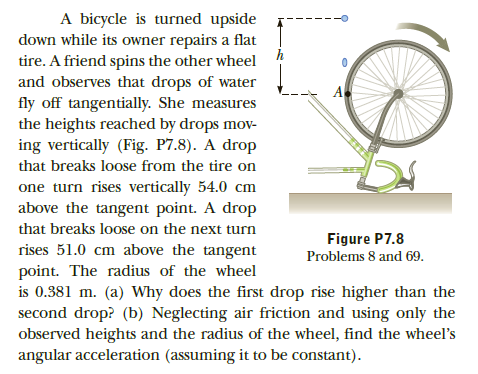A bicycle is turned upside down while its owner repairs a flat tire. A friend spins the other wheel and observes that drops of water fly off tangentially. She measures the heights reached by drops mov- ing vertically (Fig. P7.8). A drop that breaks loose from the tire on one turn rises vertically 54.0 cm above the tangent point. A drop that breaks loose on the next turn Figure P7.8 rises 51.0 cm above the tangent point. The radius of the wheel is 0.381 m. (a) Why does the first drop rise higher than the second drop? (b) Neglecting air friction and using only the observed heights and the radius of the wheel, find the wheel's angular acceleration (assuming it to be constant). Problems 8 and 69.
A bicycle is turned upside down while its owner repairs a flat tire. A friend spins the other wheel and observes that drops of water fly off tangentially. She measures the heights reached by drops mov- ing vertically (Fig. P7.8). A drop that breaks loose from the tire on one turn rises vertically 54.0 cm above the tangent point. A drop that breaks loose on the next turn Figure P7.8 rises 51.0 cm above the tangent point. The radius of the wheel is 0.381 m. (a) Why does the first drop rise higher than the second drop? (b) Neglecting air friction and using only the observed heights and the radius of the wheel, find the wheel's angular acceleration (assuming it to be constant). Problems 8 and 69.
University Physics Volume 1
18th Edition
ISBN:9781938168277
Author:William Moebs, Samuel J. Ling, Jeff Sanny
Publisher:William Moebs, Samuel J. Ling, Jeff Sanny
Chapter10: Fixed-axis Rotation
Section: Chapter Questions
Problem 10.2CYU: Check Your Understanding A centrifuge used in DNA extraction spins at a maximum rate of 7000 rpm,...
Related questions
Question

Transcribed Image Text:A bicycle is turned upside
down while its owner repairs a flat
tire. A friend spins the other wheel
and observes that drops of water
fly off tangentially. She measures
the heights reached by drops mov-
ing vertically (Fig. P7.8). A drop
that breaks loose from the tire on
one turn rises vertically 54.0 cm
above the tangent point. A drop
that breaks loose on the next turn
Figure P7.8
rises 51.0 cm above the tangent
point. The radius of the wheel
is 0.381 m. (a) Why does the first drop rise higher than the
second drop? (b) Neglecting air friction and using only the
observed heights and the radius of the wheel, find the wheel's
angular acceleration (assuming it to be constant).
Problems 8 and 69.
Expert Solution
This question has been solved!
Explore an expertly crafted, step-by-step solution for a thorough understanding of key concepts.
This is a popular solution!
Trending now
This is a popular solution!
Step by step
Solved in 4 steps with 3 images

Recommended textbooks for you

University Physics Volume 1
Physics
ISBN:
9781938168277
Author:
William Moebs, Samuel J. Ling, Jeff Sanny
Publisher:
OpenStax - Rice University

Glencoe Physics: Principles and Problems, Student…
Physics
ISBN:
9780078807213
Author:
Paul W. Zitzewitz
Publisher:
Glencoe/McGraw-Hill

An Introduction to Physical Science
Physics
ISBN:
9781305079137
Author:
James Shipman, Jerry D. Wilson, Charles A. Higgins, Omar Torres
Publisher:
Cengage Learning

University Physics Volume 1
Physics
ISBN:
9781938168277
Author:
William Moebs, Samuel J. Ling, Jeff Sanny
Publisher:
OpenStax - Rice University

Glencoe Physics: Principles and Problems, Student…
Physics
ISBN:
9780078807213
Author:
Paul W. Zitzewitz
Publisher:
Glencoe/McGraw-Hill

An Introduction to Physical Science
Physics
ISBN:
9781305079137
Author:
James Shipman, Jerry D. Wilson, Charles A. Higgins, Omar Torres
Publisher:
Cengage Learning

Physics for Scientists and Engineers: Foundations…
Physics
ISBN:
9781133939146
Author:
Katz, Debora M.
Publisher:
Cengage Learning